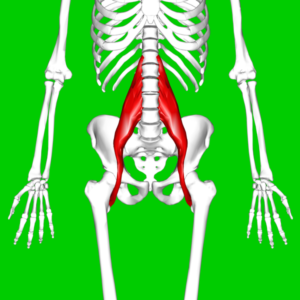 The Psoas muscle is a muscle that is becoming very popular today. It has always been an important muscle, but now it seems, yoga teachers, physical therapists, and sports enthusiasts are realizing just how important it really is to an individual’s overall health. The Psoas is each of a pair of large muscles that run from the bottom of the thoracic and lumbar spine through the groin on either side and, with the iliacus, flex the hip.
The Psoas muscle is a muscle that is becoming very popular today. It has always been an important muscle, but now it seems, yoga teachers, physical therapists, and sports enthusiasts are realizing just how important it really is to an individual’s overall health. The Psoas is each of a pair of large muscles that run from the bottom of the thoracic and lumbar spine through the groin on either side and, with the iliacus, flex the hip.
When you walk up and down stairs and do many other activities, it plays a critical role in ones’ day- to- day movement, especially as one grows older.
From a Rolfing point of view, it is a muscle that is not used enough. Today, the design of office chairs, the vehicles we drive, and/or our comfortable living room furniture, is simply not designed in our best interest. Part of the problem is that modern-day furniture forces us to contract and shorten the Psoas, gearing it out of participation in walking while leading us to an overuse of our exterior sleeve muscles; think, Hamstrings and Quads.
As we move away from using perhaps our most important core muscle, walking requires ever more effort and becomes less graceful. If we have experienced emotional trauma, we often avoid contact with both our emotional and structural core.
Ida Rolf, the developer of Rolf Structural Integration or Rolfing, referred to the Psoas muscle as “The Rolf muscle”. She believed that if we were using the Psoas the way our bodies’ Template would suggest, then it would function as the most important muscle to maintain proper posture, alignment and ease of movement.
Here are some issues that people experience as a result of not using their Psoas muscle:
Wear and tear on their spinal discs. When the Psoas muscle is not used as it should, the pelvis will often be brought into an anterior tilt leading the lumbar area to shorten and compress, contributing to a lumbar lordosis or “swayback”, which will put pressure on the discs and spinal nerves. If that doesn’t sound painful enough, just know that an anteriorly tilted pelvis will compress the heads of your femurs into the hip, leading may folks to a hip replacement. A tilted pelvis can also be a triggering event for scoliosis.
There can be a profound effect on breathing because the connective tissue or facial wrappings that wrap around the Psoas muscle, extend to the respiratory diaphragm muscle. This will have a direct effect on breathing when doing something as simple as walking.
Besides hip, low back, spinal disc pain and challenged breathing, a shut-down or imbalanced Psoas can gift you with pelvic pain, sexual dysfunction and incontinence. If one Psoas muscle is shorter than the other, one hip may be higher or the pelvis could twist and torque.
In the course of a normal day, an occupation that includes sitting and leaning forward such as working on a computer for 6 to 8 hours, creates an enormous stress on the body. The problem is exacerbated once the person leaves the office and gets into their vehicle to drive home. The seating in both situations typically tilts the pelvis back and the knees up, which results in the turning off of the Psoas muscle.
The Psoas muscle also supports your internal organs and works like a hydraulic pump, allowing blood and lymph to be pushed in and out of the cells of your organs. Also, a shortened Psoas muscles will shrink the amount of space our organs have in the abdominal cavity. In other words, it plays an important role in your organ health.
Here is a Rolfing exercise that you can do once per day, to help keep your Psoas muscles long and active: Stand with your left foot and leg on a ream of paper and swing your right leg back and forth, with your right foot gently scuffing the floor. The moving leg should have the quality of a bell clapper swinging inside a large church bell. Do this 6-8 times. Switch legs and repeat the movement. If needed, you can do this within an arms reach of a wall, while lightly touching the wall with a finger for balance.
Please remember that no muscle or postural distortion exists in isolation from other tight and shortened areas, or the ways in which our bodies as a whole have adapted to our struggle to stay upright in the gravitational field of the planet. You may want to seek out a skilled structural bodyworker who knows the right sequence of steps to bring the totality of your structure back into harmony with this beautiful planet we call, home.
To your good health! Robert
Robert Auerbach is a Certified Advanced Practitioner of Structural Integration. Call him today! 313-407-6343. Email: rolfmagic@talkamerica.net or visit his website: www.rolf-michigan.com Learn about Structural Integration aka/Rolfing sessions at www.youtube.com/watch?v=aUDwj_QVXwU












